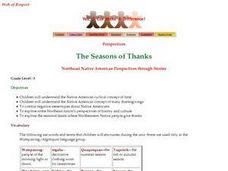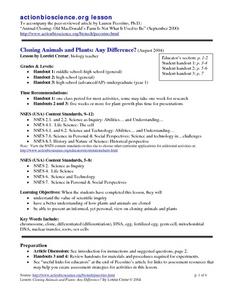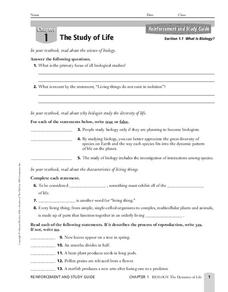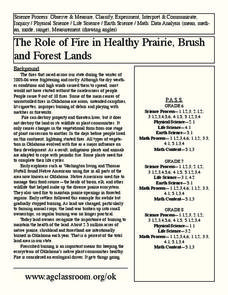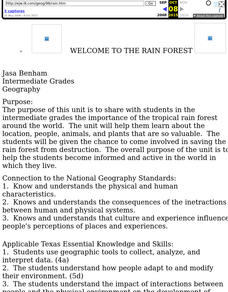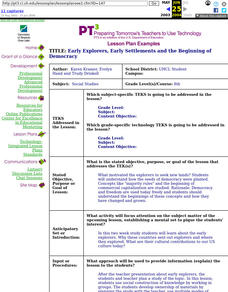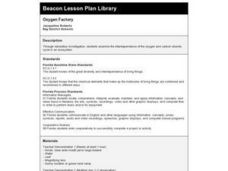Curated OER
The Seasons of Thanks
First graders explain the Native American cyclical concept of time
Curated OER
Food Webs
Students research what food is eaten by the following organisms: penguins leopard seals, krill, elephant seals, petrels, albatross, fur seals, squid, insects and grass. They make a food web using the data they have gathered.
Curated OER
Co-evolution of Plants and Pollinators
Students, while studying the rolls of pollinators and plants, explore co-evolution of mutualistic relationships.
Curated OER
Water Quality and Dissolved Oxygen
Students investigate the relationship between dissolved oxygen and organic materials and aquatic organisms. This is a 3-instructional activity series in which students explore dissolved oxygen and then design an experiment testing the...
Curated OER
Invasive Species
Learners study exotic and native species, and examine how exotic species can impact native ones. They study how the mute swan effects native species.
Curated OER
Cloning Animals and Plants: Any Difference?
Students examine the process in which plants and animals are cloned. They compare and contrast the two procedures and determine if there is a difference. They share their views on cloning to the class.
Curated OER
Will Biotech Crops Solve World Problems?
Students read an online article to examine what biotechnology and agricultural biotechnology are. They answer questions and complete worksheets based on the article's information.
Curated OER
Go Fish!
Students are introduced to the culture of the Kumeyaay. Using their text, they discover how they used their native flora and fauna in San Diego. They participate in a matching game and examine the types of organisms who make their home...
Curated OER
What is Biology?
In this science of biology worksheet, students will review the concepts relating to biology including the characteristics of living things, the process of reproduction, adaptations, and evolution. This worksheet has 5 short answer, 3...
Curated OER
Fungus Among Us- Non-Fiction Reading Comprehension Worksheet
In this fungus non-fiction reading comprehension worksheet, students read a 3 page selection that describes the characteristics and life of fungi. They answer 10 questions based on the reading which include true or false, multiple...
Curated OER
Animal Life Cycles
Students participate in numerous activities to gather information about parts of the life cycle. In this life science lesson, the teacher choose from a number of activities to create or support an interdisciplinary unit about the life...
Curated OER
Early Colonial Labor Force: Indentured Servants and Slaves
Students study the labor force used during Colonial America. In this Colonial America lesson, students discuss labor types used in the colonies. Students read about indentured servants and the use of African slaves. Students...
Curated OER
Circles in the Landscape: Irrigating Oklahoma Crops
How do you grow crops in a area with insufficient rainfall? Why you irrigate, of course. Class members investigate irrigation systems by designing a system of their own. After examining irrigation related concepts, vocabulary terms, and...
Curated OER
The Role of Fire in Healthy Prairie, Brush and Forest Lands
Middle schoolers create a Venn diagram to compare and contrast wildfires and prescribed fires. In this earth science instructional activity, students conduct a series of experiment to explore fire characteristics. They describe favorable...
Curated OER
Scientists and Inventors
Students explore human discovery by reading historical stories in class. In this inventors lesson, students define the terms scientist, invention, inventor and discovery before discussing the many differences between them. Students read...
Curated OER
Welcome to the Rain Forest
Fourth graders become aware of the worlds rain forest and study the plants of the rain forest and the adaptations they have made to survive in the environment.
Curated OER
Early Explorers, Early Settlements and the Beginning of Democracy
Eighth graders research and discuss the early explorers, why countries sent out explorers, where they explored, and what their cultural contributions are to our US culture today.
Curated OER
Oxygen Factory
Fourth graders examine the interdependence of the oxygen and carbon dioxide cycle in an ecosystem through a laboratory investigation. After a lecture/demo, 4th graders complete the lab in groups.
Curated OER
Plants and Animals of Great Bay Animals and Plants of the Estuary
Students participate in a webquest about the plants and animals that inhabit an estuary. They role play as environmentalists researching this habitat and present the results of their research in a creative way.
Curated OER
Genetics: Mice Rule! (Or Not)
Learners explore genetics and evolution by examining a hypothetical mouse population. Using coin tosses, they determine mouse traits of parents and offspring. Finally, they consider the outcomes of changing environmental conditions on...
Curated OER
A Tree Is More than a Street Name
Eighth graders discuss the role of trees as one of the most important natural resources. In groups, they examine how the forests nearby helped to shape their urban city. Using the internet, they research the use of the forest in early...
Curated OER
What's For Dinner?
Students explore the food chain. They brainstorm and create a consumer-consumed food chains using magazine pictures and research materials. Students identify consumer-consumed relationships.
Curated OER
Prairies
Students identify the basic characteristics of the prairie ecosystem, and several commonly known prairie species. They create a classroom mural of a prairie ecosystem; and create reports about what they have found out.
Curated OER
Why preserve biodiversity?
Learners view photos of endangered species on the Internet and discuss the reasons why these animals are threatened and why they should be protected. They use the words: biodiversity, ecosystem, and extinction in sentences to demonstrate...
Other popular searches
- Plant Diversity Activities
- Plant Diversity Map
- Genetics and Plant Diversity
- Plant Diversity Section 22.2
- Plant Diversity Section 222
- Plant Diversity Worksheet


